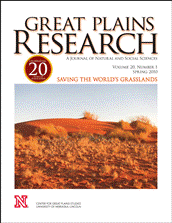Center for Great Plains Studies

Great Plains Research: A Journal of Natural and Social Sciences (through 2013)
Date of this Version
Spring 2010
Document Type
Article
Citation
Published in Great Plains Research 20.1 (Spring 2010): 135.
Abstract
Rewilding the West gives a first impression of being the story of an innovative conservation project—creation of a 3.5 million-acre wildlife preserve from both public and private lands, restocked with bison and other traditional Plains wildlife—in the Missouri Breaks of eastcentral Montana. However, Manning only devotes thirteen pages to the project at the end of the book, with a few additional references to it scattered throughout. Instead, he traces the history of the site, from the days of the bison to modern times. In doing so, he provides a fascinating and useful frame of reference for current conservation efforts in the Northern Plains by describing how people have transformed one of the planet’s most productive, wildlife-rich environments to one ecologically degraded, underconserved, and forgotten by most Americans. To Manning, this project promises to return at least one important part of the Northern Plains to productivity, for wildlife and people, by “reconcile[ing] nature and economy to create a working landscape.”
Manning develops several themes throughout the book. The native plants and animals of the Plains have coevolved in a delicate balance, thriving in adaptation to the region’s fierce and unpredictable climate. Agriculture, whether livestock grazing or crop production, cannot be sustained in this harsh environment without considerable government support. Even worse, agriculture has led to the destruction of the Plains’ unique ecology, removing its large grazers like bison and elk, eradicating its top predators, breaking up the grassland and putting its topsoil to the wind, and damming its rivers and streams. Mostly failed government policies from both ends of the political spectrum drove this change, Manning claims: “[t]he progressive zeal of the reformer is every bit as dangerous as the swagger of the cowboy, and, conversely, the ‘conservative’ West is almost wholly a creature of the nation’s most socialist of projects, the New Deal.” Manning concludes with the argument that only a return to an economy based on wildlife can provide a sustainable livelihood for people in this region.


Comments
Copyright 2010 Center for Great Plains Studies, University of Nebraska-Lincoln. Used by permission.